Search:
Powered by
Website Baker
1864 West Mississippi Tug of War |
| Posted by The Muse (themuse) on Sep 16 2014 |
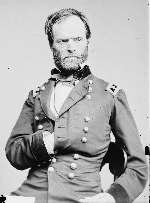
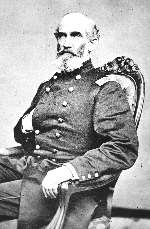 In the summer of 1864, two senior Union commanders were engaged in a tug-of-war over the services of Major General A. J. Smith. Earlier that year, Major General William T. Sherman had detached Smith’s command to operate west of the Mississippi River. Now Sherman wanted Smith’s command for the Atlanta campaign. But Major General Edward R. S. Canby, commanding the Military Division of West Mississippi, needed Smith’s infantry to fight Confederate forces west of the Mississippi River. Canby was tasked with keeping the Mississippi River under Union control, preventing Confederates from crossing the river to reinforce Atlanta, and protecting Sherman’s supply lines. During this struggle for his services, Smith found his command diverted to counter another Confederate threat, an invasion of Missouri by Major General Sterling Price.
In the summer of 1864, two senior Union commanders were engaged in a tug-of-war over the services of Major General A. J. Smith. Earlier that year, Major General William T. Sherman had detached Smith’s command to operate west of the Mississippi River. Now Sherman wanted Smith’s command for the Atlanta campaign. But Major General Edward R. S. Canby, commanding the Military Division of West Mississippi, needed Smith’s infantry to fight Confederate forces west of the Mississippi River. Canby was tasked with keeping the Mississippi River under Union control, preventing Confederates from crossing the river to reinforce Atlanta, and protecting Sherman’s supply lines. During this struggle for his services, Smith found his command diverted to counter another Confederate threat, an invasion of Missouri by Major General Sterling Price.
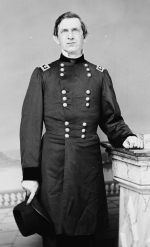 After the Red River debacle, Banks was ordered to report to New Orleans, and Major General Edward R. S. Canby was placed in command of the Division of West Mississippi. As part of this reorganization, Andrew Jackson Smith received a promotion to Major General of Volunteers. But he was still delayed in returning to Sherman’s Army of the Tennessee. Canby was concerned about enemy activity in Arkansas and decided to retain Smith to counter that threat. But on June 1, Smith received orders to move the Right Wing, 16th Army Corps from Vicksburg to Memphis, Tennessee. His objective was to prevent Confederate General Forrest from wreaking havoc on Sherman’s supply lines. [i]
After the Red River debacle, Banks was ordered to report to New Orleans, and Major General Edward R. S. Canby was placed in command of the Division of West Mississippi. As part of this reorganization, Andrew Jackson Smith received a promotion to Major General of Volunteers. But he was still delayed in returning to Sherman’s Army of the Tennessee. Canby was concerned about enemy activity in Arkansas and decided to retain Smith to counter that threat. But on June 1, Smith received orders to move the Right Wing, 16th Army Corps from Vicksburg to Memphis, Tennessee. His objective was to prevent Confederate General Forrest from wreaking havoc on Sherman’s supply lines. [i]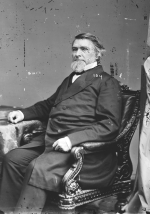 It was in August, during Smith’s operations in northern Mississippi, that Major General Cadwallader C. Washburn was fed up with the tug of war for troops that was going on between Sherman and Canby. After he received an order to send 17th Army Corps troops east, Washburn fired back a plaintive telegram.
It was in August, during Smith’s operations in northern Mississippi, that Major General Cadwallader C. Washburn was fed up with the tug of war for troops that was going on between Sherman and Canby. After he received an order to send 17th Army Corps troops east, Washburn fired back a plaintive telegram.Special Field Orders, No. 90, dated August 6, in regard to the troops of the Seventeenth Corps, has been received. I regret to say that I cannot comply with it, for the reason that the troops are now serving in Arkansas, having been sent there … pursuant to an order from Major-General Canby … My position recently has been quite embarrassing from the conflicting orders which I have received from Generals Canby and Sherman. The last expedition of General Smith, which resulted in the defeat of Forrest, I should have had to abandon had I not disobeyed General Canby's orders … You will readily see my awkward position. I write to know what I am to do when I receive orders from Generals Sherman and Howard directing me to do one thing, and from General Canby directing me to do the opposite? [ii]
General Canby's orders and mine begin to conflict on the Mississippi. My orders are for A. J. Smith to come across to Decatur, and General Canby orders Washburn to hold 5,000 men to be ready for his call. He cannot do both. I think that the Department of the Tennessee extends over the territory east of the river, and that we control it, and have the nomination of all post commanders; but they must assist Canby in maintaining the navigation of the river. Still, I do not wish to make points of difference at this time. Please define clearly our boundaries, that our subordinates may not infer a conflict of authority. [iii]
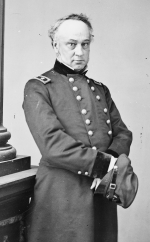 Halleck replied to Sherman, arguing that for Canby to protect navigation on the Mississippi, he needed to control the troops on both sides of the river. Also, Canby needs troops to prevent Confederate General Kirby Smith from crossing the river with troops to reinforce Lieutenant General John Bell Hood in Atlanta. Sherman really wanted Smith to return to the Army of the Tennessee but was willing to “admit the wisdom of General Canby exercising command of all the troops on the Mississippi.” So for now, A. J. Smith would stay near Memphis, Tennessee. [iv]
Halleck replied to Sherman, arguing that for Canby to protect navigation on the Mississippi, he needed to control the troops on both sides of the river. Also, Canby needs troops to prevent Confederate General Kirby Smith from crossing the river with troops to reinforce Lieutenant General John Bell Hood in Atlanta. Sherman really wanted Smith to return to the Army of the Tennessee but was willing to “admit the wisdom of General Canby exercising command of all the troops on the Mississippi.” So for now, A. J. Smith would stay near Memphis, Tennessee. [iv]General W. T. Sherman has authorized me to retain Mower's division, sending him only Smith's old division. This will as soon as Mower returns enable me to give you a force of 5,000 men, should you require them. General Sherman desires that the troops at Saint Charles, being fractional regiments of the Seventeenth Corps, be sent to him. I shall send Smith to General Sherman as rapidly as possible by river and railroad, moving him back here for that purpose. Mower and the cavalry will remain at Holly Springs to watch Forrest, unless you require Mower, in which case he can be moved in one day from Holly Springs here. [vi]
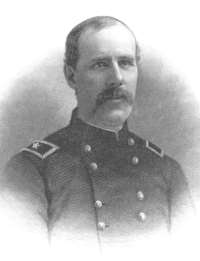
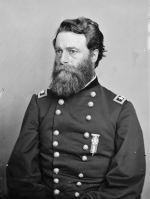 But Mower’s First Division was going to be ordered into Arkansas. Confederate Major General Sterling Price was on the move in Arkansas, and the Federal commander there, Major General Frederick Steele was asking for reinforcements. Canby had Major General Washburn order Brigadier General Joseph A. Mower and the First Division to Steele’s command in Little Rock, Arkansas. Washburn also sent Colonel Edward F. Winslow, Second Division, Cavalry Corps, District of West Tennessee with detachments numbering 1,900 to Arkansas on September 2. [vii]
But Mower’s First Division was going to be ordered into Arkansas. Confederate Major General Sterling Price was on the move in Arkansas, and the Federal commander there, Major General Frederick Steele was asking for reinforcements. Canby had Major General Washburn order Brigadier General Joseph A. Mower and the First Division to Steele’s command in Little Rock, Arkansas. Washburn also sent Colonel Edward F. Winslow, Second Division, Cavalry Corps, District of West Tennessee with detachments numbering 1,900 to Arkansas on September 2. [vii]Halleck to Sherman: General Washburn telegraphs that Price, [John S.] Marmaduke, and [Jo] Shelby are preparing a raid against Missouri of 10,000 or 12,000 mounted troops. I have directed General A. J. Smith to halt at Cairo for further orders. If you can spare Smith, and Washburn's story proves true, I think Smith's force should be sent against Price. Please answer.
Sherman to Halleck: Have received your dispatch about Gen. A. J. Smith; certainly use him to check Price.
You will prepare your command to immediately take the field west of the Mississippi against Price & Co. [ix]
I have been trying for three months to get you and Mower to me, but am headed off at every turn. General Halleck asks for you to clean out Price. Can't you make a quick job of it and then get to me? Your command belongs to me, and is only loaned to help our neighbors, but I fear they make you do the lion's share. However, do as General Halleck orders, and as soon as possible come to me. [x]
Last changed: Sep 16 2014 at 9:16 AM
Back